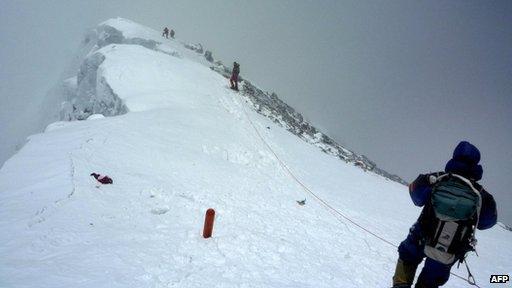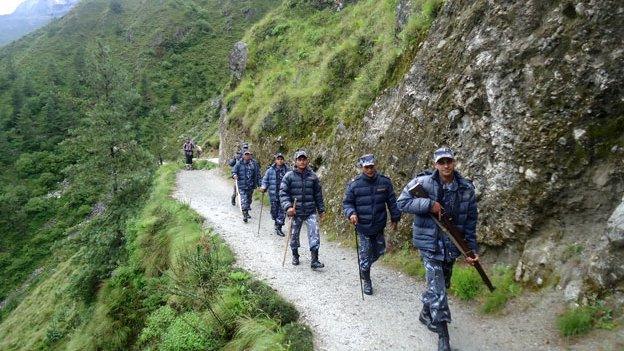Nepal seeks to attract more tourists from Asian nations
- Published

Nepal is a popular tourist destination with adventure and thrill seekers
Nepal's most iconic symbol - Mount Everest, the world's highest peak - and other tall mountains attract tens of thousands of foreign tourists, particularly from Western Europe, the United States and Japan.
Home to eight of the highest mountains in the world, the Himalayan nation has been a paradise for adventure seekers offering them ultimate challenges.
As the country emerges from a decade-long civil war between security forces and Maoists, tourism officials here believe it is now time to showcase the country's other cultural riches to the world.
Nepal, home to the birthplace of Lord Buddha and a number of the most sacred Hindu sites, wants to attract visitors interested in its rich history and culture.
"We are now targeting new economies like China, India, Korea, Malaysia and Thailand," says Sushil Ghimire, Secretary of the Nepal Ministry of Culture and Tourism.
He explains that not only are these nations close to Nepal, but they also "share similar socio-cultural conditions".
Important industry
The tourism sector is a key contributor to Nepal's economic growth.
Despite its political instability and poor infrastructure, the country attracted nearly 600,000 foreign tourists in 2012, a 10% cent increase on the previous year.
The industry provides employment to more than 750,000 people in a country where the unemployment rate is more than 45%.
Last year the tourism sector earned revenues of $370m (£245m) - nearly 3% of the country's gross domestic product (GDP).
It is also the second biggest foreign income earner after remittances from abroad by Nepalese workers.
And these numbers are likely to increase in the coming years.
The number of Chinese visiting Nepal has seen a big jump with nearly 75,000 tourists coming to the country last year, a 60% increase from the previous year.
Tourist numbers from Nepal's other giant neighbour, India, are also on the rise.
While their focus is on attracting a new segment of tourists, officials are also trying hard to provide more options for their existing adventure tourists, who constitute about 40% of the market.
Last year, they introduced a "Guerrilla Trail", a trek through the battle grounds of the country's bloody war with Maoist rebels, which ended in 2006.

Officials hope the guerrilla trek will give tourists an insight into the insurgency
The three-week-long trek takes hikers across rugged mountains, rivers and villages in western Nepal.
With their new strategies, officials hope to boost tourism revenue to $500m in the next five years.
Stumbling blocks
Despite its ambitious targets, Nepal still faces a number of issues, not least a lack of adequate infrastructure.
"International air connectivity to Nepal is poor. Very few airlines fly to Nepal," says Lekha Nath Bhandari of Ample Travels in Kathmandu.
Mr Bhandari explains that this results in ticket prices surging during the peak travel season.
"An average tourist cannot afford to buy such expensive tickets," he says.
He adds that as road connectivity in Nepal is inadequate, tourists depend on domestic airlines to fly to various destinations, where once again ticket prices act as a deterrent.
Another issue is Nepal's recent record on air safety.
In the past two years there have been six air crashes, killing more than 75 tourists. Last year, a small plane carrying 19 people towards Mount Everest crashed on the outskirts of the Nepalese capital, killing everyone on board, including seven Britons and five Chinese.
At the same time, flash protests and strikes by various political parties also deter tourists.
While Nepal has enjoyed relative peace in the last five or six years, tour operators say they experience large number of cancellations during any prolonged period of strikes or protests.
'Game changer'
But the government says it is taking steps to address those concerns.
"We are upgrading our systems in airports. Modern radars will replace the existing old ones," says Mr Ghimire.
"We are also trying to establish monitoring stations in mountains so that flights can have clear visibility and good communication with the main airport in Kathmandu,"
He adds that the government is also tightening the country's aviation regulations in line with the recommendations of the International Civil Aviation Organization.
Industry players say that these changes need to come sooner rather than later. They warn that any delay may see Nepal miss out on a great opportunity.
"Tourism is a mainstay of our economy. It is one of the few industries growing in this country," says Aditya Baral, a senior official at the Nepal Tourism Board.
"If we can manage it properly, this can even be a game-changer for us in the future."
Nepal has picture postcard natural beauty. For some it has the potential to become the Switzerland of the East.
A lot will now depend on how quickly it can turn from being a risky holiday spot into a must visit destination.
- Published30 August 2012

- Published15 July 2024
